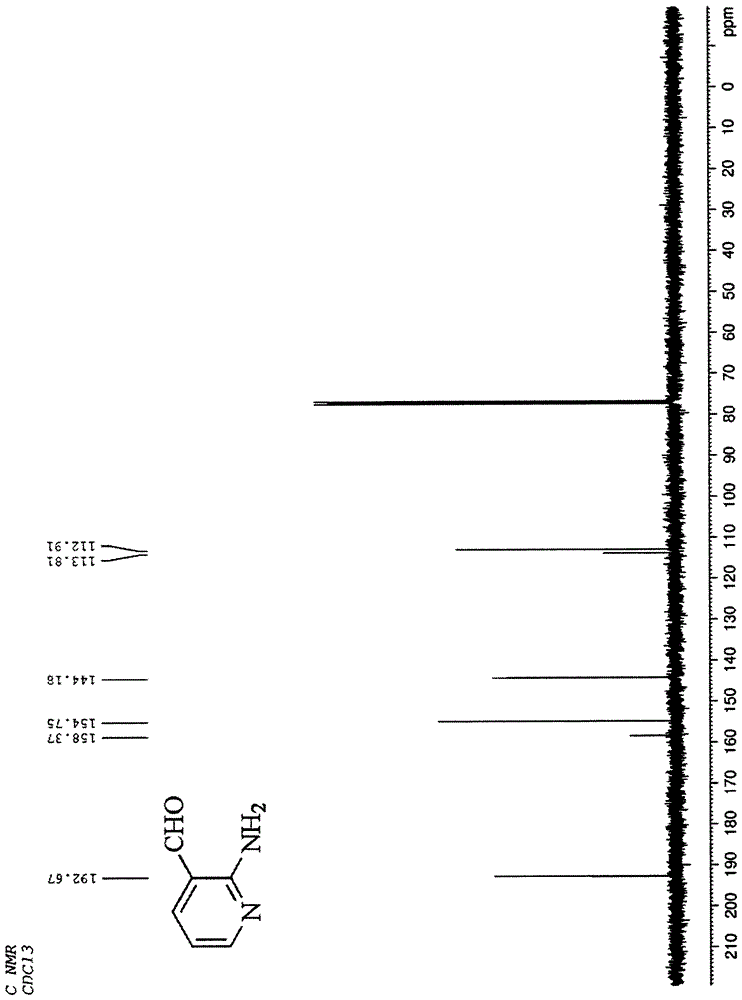A kind of rapid detection reagent for formaldehyde and its preparation method and application
A technology for detecting reagents and formaldehyde, which is applied in the field of analytical chemistry, can solve the problems of slow reaction and low sensitivity, and achieve the effects of fast response, high sensitivity and low cost
- Summary
- Abstract
- Description
- Claims
- Application Information
AI Technical Summary
Problems solved by technology
Method used
Image
Examples
Embodiment 1
[0033] Embodiment 1: the preparation of compound of the present invention
[0034] The compound of the present invention adopts following synthetic route:
[0035]
[0036] 1) Synthesis of 2-(3-pyridine)pyrido[2,3-d]pyrimidine
[0037] Weigh nicotinamide (9.12g, 0.075mol) and ammonium sulfamate (13.07g, 0.113mol) into a 50mL three-neck flask, heat the oil bath to 150°C, and then slowly increase the temperature to 200°C, The reaction was maintained at this temperature for 6 hours, then until the reaction liquid solidified completely. After the reaction is solidified, stop heating, and after cooling to room temperature, add an appropriate amount of water, then filter with suction, rinse the filter cake with water several times, wash with ether, and dry in vacuo to obtain the product 2-(3-pyridyl)pyrido[2 , 3-d] pyrimidine.
[0038] 2) Synthesis of 2-amino-3-pyridinecarbaldehyde
[0039] Prepare 2mol / L HCl solution. The dried sample was transferred to a 50 mL single-necke...
Embodiment 2
[0044] Embodiment 2: the experiment that the compound of the present invention detects formaldehyde
[0045] The aqueous solution of the compound prepared by the present invention is a colorless, transparent, non-luminescent solution, which emits strong blue fluorescence after detecting formaldehyde, such as Figure 5 It is shown that the compounds of the present invention have obvious changes before and after exposure to formaldehyde under the irradiation of 365nm hand-held ultraviolet light. Such as Figure 6 The aqueous solution of the compound of the present invention shown (the concentration of compound is 1.0 * 10 -5 M, water: ethanol = 99: 1) shows a good linear relationship between the maximum fluorescence intensity at 505 nm and the formaldehyde concentration under 400 nm light. According to this relationship diagram, the concentration of formaldehyde can be deduced from the maximum fluorescence intensity at 505nm. Figure 7 For the compound of the present inventio...
PUM
| Property | Measurement | Unit |
|---|---|---|
| decomposition temperature | aaaaa | aaaaa |
Abstract
Description
Claims
Application Information
 Login to View More
Login to View More - R&D
- Intellectual Property
- Life Sciences
- Materials
- Tech Scout
- Unparalleled Data Quality
- Higher Quality Content
- 60% Fewer Hallucinations
Browse by: Latest US Patents, China's latest patents, Technical Efficacy Thesaurus, Application Domain, Technology Topic, Popular Technical Reports.
© 2025 PatSnap. All rights reserved.Legal|Privacy policy|Modern Slavery Act Transparency Statement|Sitemap|About US| Contact US: help@patsnap.com



